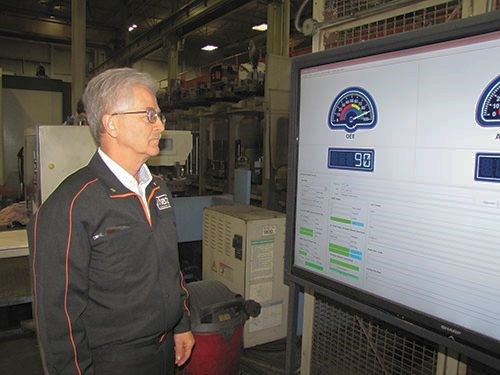Surprises from Machine Monitoring
When Mazak implemented an MTConnect-enabled machine monitoring system at its machine-tool factory in Florence, Kentucky, the data yielded some surprising results when analyzed. Read about what was discovered here.
Share





Ben Schawe, VP of manufacturing at Mazak, checks one of the 60-inch flat-screen displays that show vital statistics about the machines being monitored.
When Mazak implemented an MTConnect-enabled machine monitoring system at its machine-tool factory in Florence, Kentucky, the data yielded some surprising results when analyzed.
For example, a number of part programs included optional stops originally added so that operators could check tool wear periodically or measure a critical part feature during the prove-out of the process. When the part went into production, however, these optional stops were never removed from the part program, or operators simply got in the habit of restarting the machine at these points in the program. The high occurrence of stoppages linked to these programmed stops showed up in the reports and they could be traced to the cause. Systematically editing the part programs to remove these unnecessary optional stops was an easy way to recover the lost production time.
A similar pattern was detected in stoppages for tool changes. Some operators were stopping the machine every time the access to the tool magazine was opened to replace or check a cutting tool. Instead of using the feed-hold button, which stops the machine, they should have been using the magazine manual interrupt switch, which enables the machine to continue running safely while they perform tool maintenance. Training that addressed this issue took care of the problem.
Analyzing stoppages also revealed more subtle situations. For example, an unusual number of machine stops were reported with a certain run of part castings. Checking with the operators revealed that castings of the same part sourced from two different foundries were not identical. Dissimilarities in the foundry patterns created excess stock conditions that required the operator to interrupt the part program to manually add a second tool pass on the affected castings.
In other cases, the operators could point to data as evidence that a persistent shortage of a certain cutter type was holding back productivity. Because adequate spare tools were not available, the machine had to be stopped to index inserts on the spot instead. Acquiring additional tool cutter bodies help resolve these delays. In fact, a more general pattern of not having sufficient replacement tools ready to restock tool magazines in a timely fashion was also detected. An initiative to correct this situation is now underway.
Related Content
-
The Power of Practical Demonstrations and Projects
Practical work has served Bridgerland Technical College both in preparing its current students for manufacturing jobs and in appealing to new generations of potential machinists.
-
4 Commonly Misapplied CNC Features
Misapplication of these important CNC features will result in wasted time, wasted or duplicated effort and/or wasted material.
-
Orthopedic Event Discusses Manufacturing Strategies
At the seminar, representatives from multiple companies discussed strategies for making orthopedic devices accurately and efficiently.

























